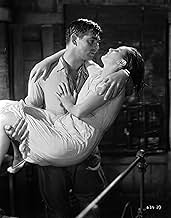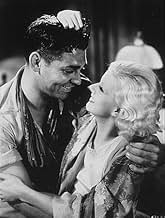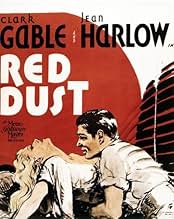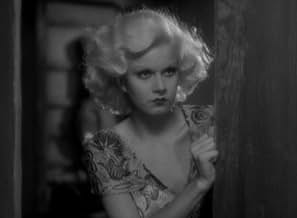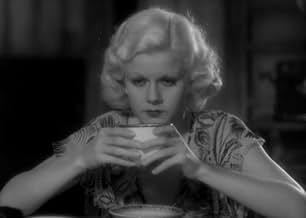NOTE IMDb
7,2/10
5,2 k
MA NOTE
Le propriétaire d'une plantation de caoutchouc se lie avec la nouvelle épouse d'un de ses employés.Le propriétaire d'une plantation de caoutchouc se lie avec la nouvelle épouse d'un de ses employés.Le propriétaire d'une plantation de caoutchouc se lie avec la nouvelle épouse d'un de ses employés.
- Réalisation
- Scénario
- Casting principal
- Récompenses
- 4 victoires au total
Avis à la une
Context is an important element in viewing any work of art or commerce and movies are both. "Red Dust" at it's core is about human weakness and strength, in degree and in full force. Mary Astor, a star since appearing opposite John Barrymore in "Don Juan", plays a repressed wife who doesn't believe in the strength of her husband (Gene Raymond) nor her own weakness when it comes to resisting the animal magnetism of rubber plantation owner Dennis (Clark Gable). Conversely, Gable doesn't realize his weakness in letting himself get involved with the ladylike Astor and underestimates the strength of prostitute Vantine (Jean Harlow) who, when Astor shoots Gable, gives witness to Raymond that his wife is innocent and that Gable deserved shooting. For it's time, 1932, "Red Dust" is sexually progressive, showing the freely running passions of Gable and the two women, while in retrospect, it's depiction of Asians is as poor stereotypes. Willie Fung, who plays Gable's houseboy, is also derided as gay in the script by the line delivered by Jean Harlow. Harlow notices Fung giggling at her underwear, to which she replies "Gee...you even find them in the jungle."
"Red Dust" has a tremendous "back story" as well. John Gilbert was to play the part of Dennis originally as an attempt to bolster his masculine image which had been damaged by the higher-than-anticipated timbre of his voice as recorded by early sound equipment. With the sensation caused by Gable when he returned Norma Shearer's slap in the face in "A Free Soul" Gable's star rose mercurily. No "hero" ever countered the indignation of the leading lady before, and certainly not the divas at Metro-Goldwyn-Mayer. Gable was a whole new breed of leading man. Jean Harlow's star had been on the ascendant after scoring a huge hit in "Red Headed Woman" a scandalous story of a secretary who sleeps her way to the top. The realism of these two performers in those films made them a natural for the raw jungle tale of passion and betrayal. In the middle of the making of the film, Jean Harlow's producer-husband, Paul Bern, was found dead. The scandal that followed frightened the studio who thought that Harlow's career was over. Scandal had ruined the careers of Fatty Arbuckle and Clara Bow, causing their studio (Paramount) to loose millions on their films. M.G.M. was surprised when Harlow's fame and popularity increased. For her part, Harlow returned to the studio and never spoke an unkind word about her late husband. Bern, it turned out, had a common law wife who had emerged from years-long institutionalization and confronted him about his new wife.
Racism is not a key element in the plot of "Red Dust". For that, you would have to see "The Mask of Fu Manchu" where the Asians are neither lazy nor stupid, but sexual predators, instead. Or you could watch any number of other World War Two American movies with Asians in them. But for accurate Pre-censorship Hollywood adult dialogue and plot, "Red Dust" will do nicely, thank you.
"Red Dust" has a tremendous "back story" as well. John Gilbert was to play the part of Dennis originally as an attempt to bolster his masculine image which had been damaged by the higher-than-anticipated timbre of his voice as recorded by early sound equipment. With the sensation caused by Gable when he returned Norma Shearer's slap in the face in "A Free Soul" Gable's star rose mercurily. No "hero" ever countered the indignation of the leading lady before, and certainly not the divas at Metro-Goldwyn-Mayer. Gable was a whole new breed of leading man. Jean Harlow's star had been on the ascendant after scoring a huge hit in "Red Headed Woman" a scandalous story of a secretary who sleeps her way to the top. The realism of these two performers in those films made them a natural for the raw jungle tale of passion and betrayal. In the middle of the making of the film, Jean Harlow's producer-husband, Paul Bern, was found dead. The scandal that followed frightened the studio who thought that Harlow's career was over. Scandal had ruined the careers of Fatty Arbuckle and Clara Bow, causing their studio (Paramount) to loose millions on their films. M.G.M. was surprised when Harlow's fame and popularity increased. For her part, Harlow returned to the studio and never spoke an unkind word about her late husband. Bern, it turned out, had a common law wife who had emerged from years-long institutionalization and confronted him about his new wife.
Racism is not a key element in the plot of "Red Dust". For that, you would have to see "The Mask of Fu Manchu" where the Asians are neither lazy nor stupid, but sexual predators, instead. Or you could watch any number of other World War Two American movies with Asians in them. But for accurate Pre-censorship Hollywood adult dialogue and plot, "Red Dust" will do nicely, thank you.
10cng4
To me this is one of the films that defined the Pre-Code Era. Complete with prostitution, adultery, sex as a major plot point, partial nudity (well, much more than was allowed during the Code enforcement), drunkenness, and strong women characters, this film has it all. Plus, it has an extremely engaging storyline, interesting setting, and an explanation of how rubber is made. Aside from the racism present, this film is great. One of the most interesting things about this film, which I have studied a great deal as a part of my senior thesis in undergrad film school, is the freshness of the dialogue. Coming only a few years after the addition of sound to films I was shocked to find how fun and refreshing the dialogue was. Whereas lots of films these days disappoint me in that the dialogue is so overly cliched and stale, Red Dust has lines about favorite cheeses and stories read about bunnies-- how fun!
All and all, this movie is terrific. Clark is as virile as anything and Jean Harlow is full of strength and sass and dimensions-- just a great female character. And hell if she isn't going to fight for her man! Mary Astor's character is also very well done as we see and believe that Clark is just so tempted by her and she by him. I recommend this movie to anyone and everyone-- It's a 120 times better than its remake, Mogambo, which despite Gable's presence just totally loses everything that Red Dust had.
All and all, this movie is terrific. Clark is as virile as anything and Jean Harlow is full of strength and sass and dimensions-- just a great female character. And hell if she isn't going to fight for her man! Mary Astor's character is also very well done as we see and believe that Clark is just so tempted by her and she by him. I recommend this movie to anyone and everyone-- It's a 120 times better than its remake, Mogambo, which despite Gable's presence just totally loses everything that Red Dust had.
A very entertaining movie with Gable and Harlow at their best.They really shine in their roles.Also a good performance by a young Mary Astor.It's easy to see that Clark Gable consolidated his newly won fame with this film.He shows his magnificent charisma on the screen perhaps for the first time to full effect.Harlow matches him all the way.An inspired pairing.
A pretty good movie. Red Dust is one of the films that made Clark Gable a star and it's easy to see why. In it, he plays the kind of likable rogue character that audiences would come to know him as. Gable is Dennis Carson, the operator of a rubber plantation in Indochina, who is all business until his world is turned upside down by two women. First Vantine Jefferson (Jean Harlow), a prostitute looking for a place to lie low arrives. Then a prospector and his wife, Barbara (Mary Astor), show up at the plantation. Both women are unwelcome intruders into Carson's world at first, but soon they each end up igniting his desire. Fooling around with the floozy Vantine is easy, but things get complicated when Carson's eye falls on the married Barbara. With his more than questionable actions, any other actor might have been completely unlikeable in the role, but Gable somehow pulls it off. Harlow and Astor also give very good performances. It helps that the heavy subject matter and brash duologue, adapted from a stage play, was not watered down too much for the screen version. Definitely a well made film worth seeing.
This actually is as good as the publicity says. Definitely one to watch.
Back in the thirties, MGM might be thought of as slightly smug and arrogant but watching this you can understand why they were a bit self satisfied. They were the studio who really knew how to make a movie.
Care, detail and time were clearly invested to evoke the feel the insect laden, steamy Indonesian rain forest where the normal constraints and rules of society don't apply. In a similar sort of way to how Coppola evoked the surreal, dislocated world of Colonel Kurtz in Apocalypse Now, Victor Fleming brings Clarke Gable's private fiefdom vibrantly to life.
What makes this film so watchable ninety years after it wowed the audiences back in 1932 are the two stars. Gable is perfect as the world's most macho man; you can almost smell the gallons of testosterone he sweats out. I've never been a fan of Jean Harlow but for once, she really shows what she can do - she is brilliant in this. You've also got to impressed by her professionalism in the way she effortlessly makes the personality of her character so real considering her husband was either murdered or committed suicide during its filming.
Back in the thirties, MGM might be thought of as slightly smug and arrogant but watching this you can understand why they were a bit self satisfied. They were the studio who really knew how to make a movie.
Care, detail and time were clearly invested to evoke the feel the insect laden, steamy Indonesian rain forest where the normal constraints and rules of society don't apply. In a similar sort of way to how Coppola evoked the surreal, dislocated world of Colonel Kurtz in Apocalypse Now, Victor Fleming brings Clarke Gable's private fiefdom vibrantly to life.
What makes this film so watchable ninety years after it wowed the audiences back in 1932 are the two stars. Gable is perfect as the world's most macho man; you can almost smell the gallons of testosterone he sweats out. I've never been a fan of Jean Harlow but for once, she really shows what she can do - she is brilliant in this. You've also got to impressed by her professionalism in the way she effortlessly makes the personality of her character so real considering her husband was either murdered or committed suicide during its filming.
Le saviez-vous
- AnecdotesDuring filming of the famous rain-barrel sequence, Jean Harlow reportedly stood up--topless--and called out something along the lines of "one for the boys in the lab!" Director Victor Fleming allegedly removed the film from the camera to prevent any footage from reaching the black market.
- GaffesWhen Clark Gable and Gene Raymond are in the tree while hunting, after the line: 'This would be a bad country to raise children in, wouldn't it?' Thecloud in the background changes dramatically.
- Citations
Barbara Willis: [watching the workers pouring liquid rubber] Why, it's milk.
Dennis Carson: Oh no, just rubber. But you could drink it if you care to stretch a point.
Barbara Willis: Oh, I once knew a man who made a joke like that. He was run over by a truck.
Dennis Carson: Were you driving it?
Barbara Willis: Yes!
Dennis Carson: Well, you're out of luck here. We only have ox-carts and every ox knows me personally.
- ConnexionsEdited into Hollywood: The Dream Factory (1972)
Meilleurs choix
Connectez-vous pour évaluer et suivre la liste de favoris afin de recevoir des recommandations personnalisées
- How long is Red Dust?Alimenté par Alexa
Détails
Box-office
- Budget
- 408 000 $US (estimé)
- Durée1 heure 23 minutes
- Couleur
- Rapport de forme
- 1.37 : 1
Contribuer à cette page
Suggérer une modification ou ajouter du contenu manquant

Lacune principale
By what name was La belle de Saïgon (1932) officially released in India in English?
Répondre
